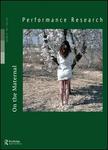版权所有:内蒙古大学图书馆 技术提供:维普资讯• 智图
内蒙古自治区呼和浩特市赛罕区大学西街235号 邮编: 010021

作者机构:Univ Essex Dept Literature Film & Theatre Studies LiFTS Colchester Essex England UK Based Theatre Co Analogue Colchester Essex England IFTR Theatre & Performance Res Working Grp Colchester Essex England
出 版 物:《PERFORMANCE RESEARCH》 (Perform. Res.)
年 卷 期:2017年第22卷第3期
页 面:30-37页
学科分类:1303[艺术学-戏剧与影视学] 13[艺术学]
摘 要:In Psychology, proprioceptive drift is a term that originates from the rubber hand illusion paradigm to describe the relative displacement of the perceived location of one s own hand toward the location of the rubber hand (Wold et al, 2014). Correspondingly, drift measurements in science are used as a means of rating the intensity of a body-ownership illusion via which a participant in a controlled experiment perceives that an extracorporeal appendage, or virtual whole-body avatar is incorporated as part of one s own body schema. In this research article, I will examine an applied performance by BeAnotherLab utilising the anti-disciplinary collective s The Machine to Be Another as part of Good Chance s Encampment project - this telepresence system produces a VR body illusion intended to increase empathy and reduce proximity between an immersant s real body and that of a volunteer refugee counterpart. When scientifically-tested body illusions cross a paradigmatic boundary to be framed as immersive art, what are the ethical implications? Furthermore, are these kinds of virtual proprioceptive transactions across different kinds of social and political boundaries symptomatic of radical empathic acts, or a capitalistic desire for the acquisition of another s experiences by virtual means? This article examines illusory bodily inhabitation through a Levinasian critical lens to consider the ethics of deterritorializing the immersant s gaze and referring their sense of touch elsewhere to produce narrative immersion .